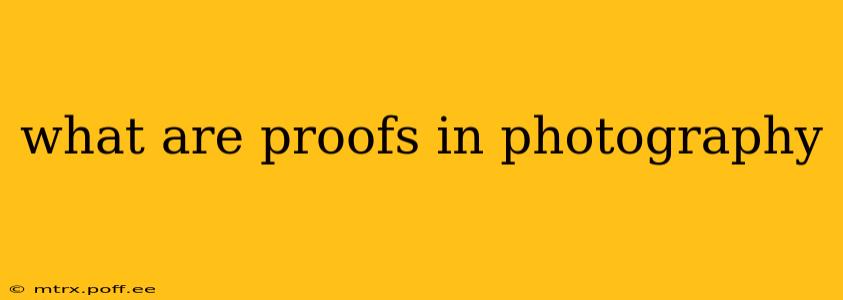In photography, "proofs" refer to preliminary versions of images, used to review, select, and potentially edit before final printing or digital delivery. They serve as a crucial step in the photographic workflow, allowing photographers and clients to assess the quality, composition, and overall success of a photoshoot. Understanding the different types of proofs is key to navigating the photographic process.
What are the different types of photographic proofs?
While the term "proof" encompasses various methods, several key types stand out:
Contact Sheets
Contact sheets are arguably the most traditional form of photographic proof. Especially prevalent in film photography, a contact sheet is a single sheet of photographic paper showing multiple small prints of negatives or slides, all in contact with the paper during development. This allows for a quick overview of an entire roll or film session, facilitating the selection of images for further processing. They're invaluable for quickly identifying successful shots and discarding unusable ones. Even in the digital age, some photographers create digital contact sheets as a way to organize and review their images efficiently.
Test Prints (Traditional Darkroom)
Before the digital era, photographers would make test prints—small prints from chosen negatives—to fine-tune aspects like contrast, exposure, and dodging and burning. Test prints offered a hands-on approach to evaluating and adjusting the final print's aesthetic. They allowed the photographer to experiment with different techniques to achieve the desired look and feel.
Digital Proofs
Digital proofs have revolutionized the photographic workflow. They typically involve providing clients with low-resolution versions of images, often with watermarks, for review and selection. This allows for efficient collaboration and selection before the final high-resolution images are processed and delivered. Digital proofs can be shared via email, online galleries, or client proofing software. They are exceptionally convenient for both photographers and clients.
Soft Proofs (Digital)
Often confused with digital proofs, soft proofs are digital previews of an image, usually on a computer screen, that simulate the final printed result. This simulation takes into account the printer's color profile and paper type to give the photographer and client a better understanding of the final print's appearance. While not technically a 'proof' in the same way as a physical print or digital image, it serves as a crucial pre-visualization tool.
What is the purpose of proofs in photography?
The core purpose of proofs is threefold:
- Selection: To efficiently select the best images from a photoshoot. Whether a contact sheet or digital gallery, proofs allow for easy comparison and selection of the most impactful and technically sound photographs.
- Review and Feedback: To provide a platform for clients (if applicable) to provide feedback and choose the images they prefer. This collaborative process ensures the final product aligns with the client's vision.
- Quality Control: To identify any technical flaws or inconsistencies, ensuring that the final images meet the desired quality standards. This could involve reviewing exposure, focus, composition, and overall aesthetic.
How are proofs used in different photographic styles?
The use of proofs varies across photographic genres:
- Wedding Photography: Digital proofs are almost universally used, allowing clients to select images for albums and prints.
- Portrait Photography: A similar approach is used, with digital proofs often provided for client selection.
- Fine Art Photography: The photographer might use test prints (or digital equivalents) to refine their vision before producing final prints, even without client input.
- Photojournalism: Contact sheets are frequently used for quick image selection, often for rapid turnaround times.
What is the difference between proofs and final images?
The key distinction lies in the intended use and level of finishing. Proofs are preliminary; final images are the polished, high-resolution, ready-to-use versions. Proofs may be low-resolution, watermarked, or have minor imperfections, whereas final images are optimized for quality and intended for printing, display, or distribution.
By understanding the different types of photographic proofs and their applications, photographers can streamline their workflow, collaborate effectively with clients, and produce high-quality final products. The choice of proof type depends on the specific photographic genre, client needs, and the photographer's workflow preferences.
